Store your unopened pickled onions in a cool, dark place for up to 2 years, ensuring jar lids are properly sealed. Once opened, transfer them to the refrigerator at 40°F (4°C) or below, where they'll last 2-3 months. You'll want to keep the onions fully submerged in their brine using glass containers with tight-fitting lids. Check regularly for signs of spoilage like mold, unusual odors, or mushy texture. For extended storage, you can freeze pickled onions for 6-8 months in airtight containers. There's much more to mastering pickled onion preservation than meets the eye.
Best Storage Before Opening
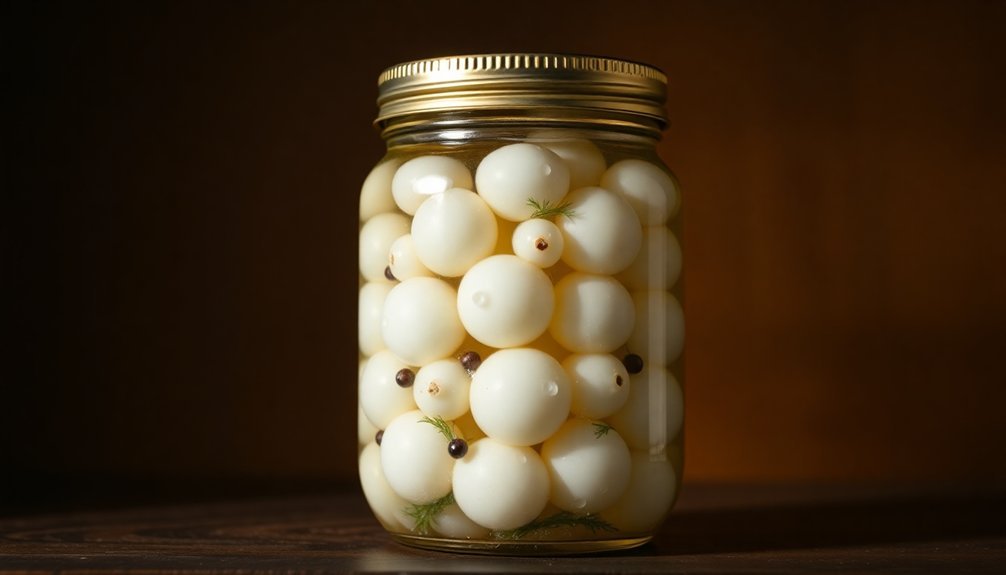
Make sure your pickled onions are in shelf-stable jars with proper sealing. After processing, you'll need to check the jar lids within 12 to 24 hours to confirm they're properly sealed.
Once you've verified the seal, remove the screw-on bands and label each jar with the processing date. This step helps you track shelf life, which typically ranges from 12 to 18 months.
Store your jars in a cool, dark place for optimal flavor preservation. Don't store your jars near heat sources or in areas with temperature fluctuations. Keep them upright and undisturbed during the cooling process.
While some guidelines suggest up to 2 years of storage for certain pickled foods, it's safest to follow the USDA's recommendation of a 12-month maximum.
Remember to inspect your jars periodically for any signs of spoilage, even before the estimated expiration date.
Proper Refrigeration After Opening
Once your pickle jar is open, proper storage becomes essential for maintaining both safety and flavor. Keep your pickled onions in the refrigerator at a temperature below 40°F (4°C) to slow down fermentation and preserve their crisp texture.
Place them away from direct light and areas with high humidity to prevent premature spoilage. Commercially prepared pickled onions can last up to 6 months when refrigerated properly.
Transfer your pickled onions to an airtight container or use a mason jar with a tight-fitting lid if the original packaging isn't suitable. This won't just contain the oniony smell but will also protect other foods in your fridge from absorbing the aroma.
Make sure you're using clean, sterile containers to extend shelf life.
Always keep the onions completely submerged in their pickling brine. If you notice the liquid doesn't fully cover the onions, add more vinegar solution until they're completely covered. This acidic environment is vital for preservation.
Don't forget to monitor your pickled onions regularly for signs of spoilage. Watch for unusual odors, slimy texture, or mold growth.
Label your container with the date you opened it, and discard any onions that show signs of deterioration.
Understanding Shelf Life
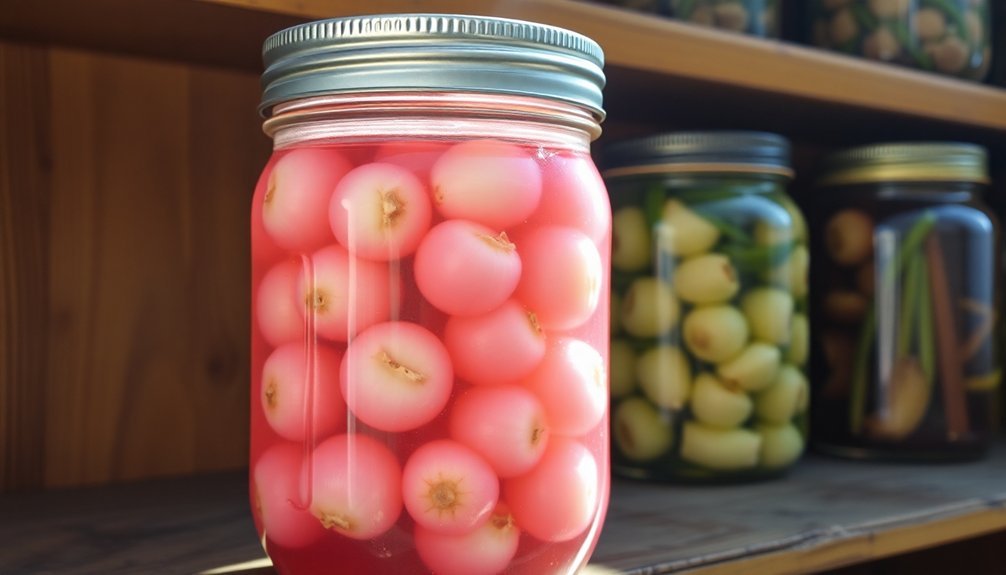
Your pickled onions' shelf life varies dramatically based on whether they're store-bought, homemade, or home-canned, with unopened commercial versions lasting up to 2 years past their printed date.
Always check that the pickling liquid remains clear as cloudy brine indicates possible spoilage. Opened jars remain good for 2-3 months in the fridge. For the best quality and flavor, you'll want to consume opened pickled onions within the first month, while homemade quick-pickled versions should be used within 2-3 weeks.
Home-canned pickled onions can stay shelf-stable for up to 2 years when unopened, but once you break the seal, plan to use them within 3-4 days for ideal freshness.
Fresh Vs Preserved Duration
Understanding the shelf life differences between fresh and preserved pickled onions is essential for proper storage and food safety. Fresh pickled onions, which you've made at home without canning, will last 1-2 weeks in the refrigerator when stored properly. In contrast, preserved pickled onions that have been properly canned can remain shelf-stable for up to 2 years when unopened.
| Storage Type | Shelf Life | Storage Method |
|---|---|---|
| Fresh Pickled | 1-2 weeks | Refrigerate in airtight container |
| Quick Pickled | Up to 2 months | Refrigerate, guarantee full liquid coverage |
| Preserved (Canned) | 1-2 years unopened, 3-4 weeks after opening | Cool, dark place; refrigerate after opening |
For both types, you'll need to watch for signs of spoilage. Fresh pickled onions may develop mold, become mushy, or have an off-odor. With preserved onions, look out for bulging lids, unusual sediment, or spurting liquid when opening. You'll get the best results by keeping fresh pickled onions fully submerged in their brine and storing preserved jars in a consistent temperature environment away from direct sunlight.
Peak Quality Timeline
While both fresh and preserved pickled onions have distinct storage periods, knowing their peak quality timeline helps you enjoy them at their best.
Unopened pickled onions maintain peak quality for 12 to 18 months when stored properly in a cool, dark place, though they'll technically remain safe to eat for 1 to 2 years past their printed date.
Once you've opened your jar of pickled onions, you'll want to consume them within 2 to 3 months if they're stored in the refrigerator. For best taste and texture, it's best to use them within the first month after opening. Keep them fully submerged in their pickling liquid and make sure the jar is tightly sealed.
If you're working with home-canned pickled onions, you can expect them to maintain quality for up to 1 year, according to USDA guidelines, though some extension programs suggest they'll last up to 2 years.
For refrigerator-pickled onions, whether homemade or commercial, you'll get the best quality within 2 to 3 months. Remember to store them in airtight containers and keep the onions submerged in brine throughout their storage period.
Storage Method Life Spans
Storage methods directly impact how long your pickled onions will remain fresh and flavorful. When you store unopened jars properly in a cool, dark pantry, they'll maintain quality for one to two years beyond the printed date. The key is keeping them away from heat, sunlight, and moisture.
Once you've opened a jar, refrigeration becomes essential. You'll get 2-3 months of shelf life when you store them at 40°F or below. Make sure you're keeping the onions submerged in their pickling liquid and securing the lid tightly after each use.
Place them away from raw meats and strong-smelling foods to prevent cross-contamination.
If you're considering long-term storage options, freezing will preserve your pickled onions indefinitely, though quality may decline after a year. You'll need to leave headspace in the container for expansion.
Alternatively, you can try home canning using a boiling water bath, which gives you up to a year of shelf life. Process pint jars for 10 minutes at altitudes up to 1,000 feet, but be prepared for slightly softer onions compared to fresh-pickled ones.
Freezing For Long Term Storage
Although freezing isn't the most common preservation method for pickled onions, you can freeze them to extend their shelf life beyond typical refrigeration. When properly stored at 0°F (-18°C), your pickled onions will maintain good quality for 6-8 months, though they'll remain safe indefinitely.
To freeze your pickled onions, drain the pickling solution and transfer them to an airtight, freezer-safe container. Leave some headspace for expansion, remove as much air as possible, and don't forget to label and date the container.
| Freezing Process | Key Details |
|---|---|
| Preparation | Drain pickling solution, use airtight container |
| Temperature | 0°F (-18°C) or below |
| Storage Time | 6-8 months for best quality |
| Thawing Method | Overnight in refrigerator |
When you're ready to use your frozen pickled onions, thaw them overnight in the refrigerator. While they'll maintain their flavor, you might notice they're less crisp than fresh ones. They'll work best in cooked dishes or as toppings where texture isn't essential. Always check for any signs of spoilage after thawing, though this rarely occurs if you've stored them correctly.
Detecting Spoiled Pickled Onions
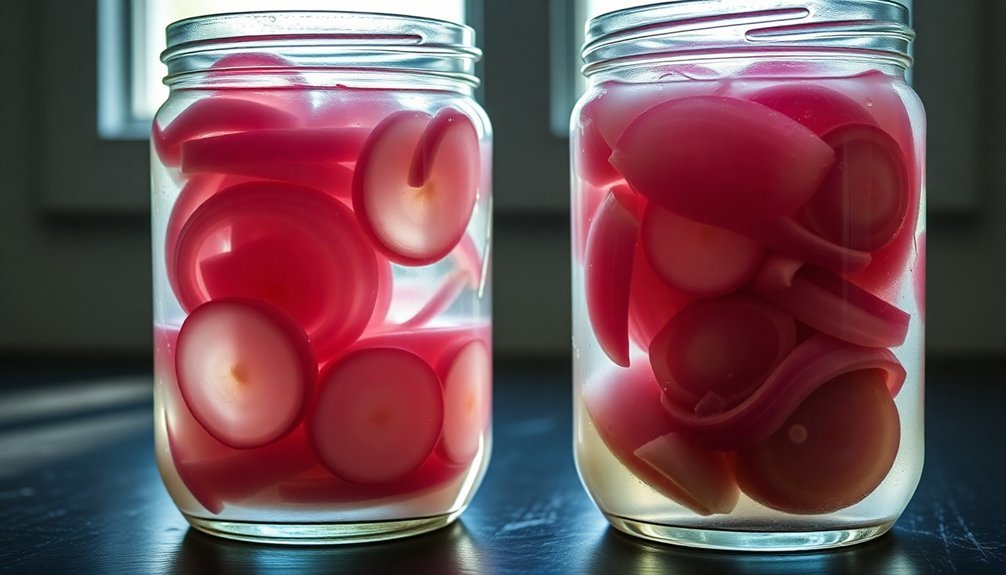
Keeping your pickled onions properly stored is only part of food safety – you'll also need to check for signs of spoilage before consuming them. When checking your pickled onions, rely on your senses to detect potential signs of deterioration.
Trust your nose first – if you notice any unpleasant, sour, or foul odors that differ from the typical vinegary smell, it's time to discard the onions.
Watch for color changes too; if your onions have darkened considerably or turned brown/gray, or if the brine has become discolored, don't consume them.
Pay attention to texture changes. Your pickled onions shouldn't be mushy, slimy, or excessively soft. If they've lost their characteristic crispness, it's best to throw them out.
Look for visible warning signs like mold growth on the onions or in the pickling liquid, unusual bubbling not caused by shaking, or cloudy brine.
Be particularly cautious if you notice any jar bulging or if liquid spurts out when opening. When onions float above the pickling liquid, this can also indicate spoilage.
If you spot any of these signs, it's safer to discard the entire jar.
Required Storage Equipment
You'll need glass containers or mason jars as your primary storage vessels for pickled onions, since glass won't react with the vinegar or absorb unwanted flavors.
Make certain your containers have tight-sealing lids to prevent air exposure and potential contamination, while wide mouths will make it easier to add and remove your pickled onions.
For safe, long-term storage, you'll also want to keep a thermometer nearby to guarantee your refrigerator maintains a temperature of 40 degrees Fahrenheit or below.
Storage Containers and Jars
When storing pickled onions, selecting the right container is essential for preserving their flavor and guaranteeing food safety. Glass containers, particularly mason jars, are your best choice because they're non-reactive and won't affect the taste of your pickled onions.
You'll want to avoid metal containers made of copper or aluminum, as they can impart metallic flavors. Similarly, don't use plastic containers since they can absorb external odors and affect the taste.
Choose containers that you can seal tightly, with mason jars of 12 oz or larger being ideal depending on your quantity needs. Pint jars are another common option for canning.
Before using any container, make sure it's clean and dry. If you're planning to can your pickled onions, you'll need to sterilize the jars first to prevent contamination.
When filling your containers, leave appropriate headspace and remove any air bubbles to guarantee the onions stay submerged in the brine. Don't forget to wipe the jar's rim clean before sealing.
Once sealed, store your pickled onions in the refrigerator at 40°F or below, or in a cool, dark place if they're properly canned.
Tools for Safe Storage
Beyond selecting the right containers, proper storage tools help maintain the quality and safety of your pickled onions. You'll need several essential items to guarantee your pickled onions stay fresh and safe for consumption. A reliable food thermometer will help you monitor the refrigerator temperature, keeping it at or below 40°F for ideal preservation.
| Storage Tool | Purpose | Key Feature |
|---|---|---|
| Food Thermometer | Temperature Monitoring | Accurate to ±2°F |
| Jar Tongs | Safe Handling | Non-slip grip |
| Bubble Popper | Air Removal | Narrow design |
To prevent contamination and maintain airtight conditions, you'll want to invest in jar tongs for safe handling and a bubble popper tool to remove trapped air. These tools help you press the onions down into the brine and guarantee proper sealing. If you're planning for long-term storage, include freezer-safe containers with expansion space and waterproof labels in your toolkit. Don't forget organizational tools like clear drawer dividers or small shelf risers to keep your pickled onions visible and accessible while preventing tipping. Having these tools ready before starting your pickling process will make storage more efficient and help maintain the quality of your preserved onions.
Temperature Control Guidelines
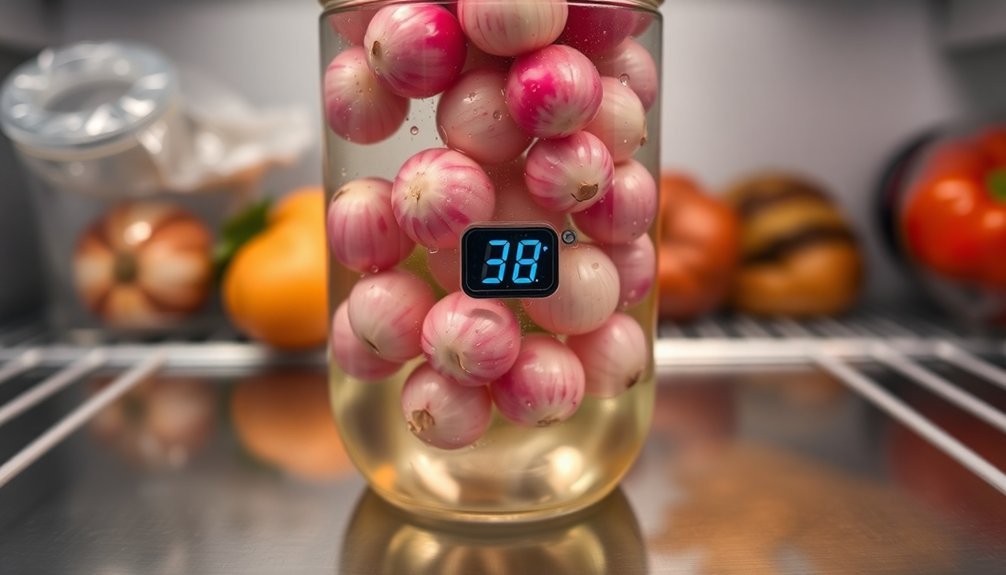
Proper temperature control is essential for maintaining the quality and safety of pickled onions. You'll need to follow specific temperature guidelines based on your pickling method to guarantee the best results.
For quick and slow pickled onions, you must store them in the refrigerator. Quick pickled varieties will last up to one month, while slow pickled onions can stay fresh for two months when properly chilled. The cold temperature prevents bacterial growth and helps maintain ideal flavor and texture.
If you're making canned pickled onions, store them in a cool, dark place away from direct sunlight. With proper storage conditions, they'll last up to a year. Remember to check the seals within 12-24 hours after cooling to guarantee safety.
For lacto-fermented pickled onions, you'll start with room temperature fermentation (60-70°F) until the process is complete. During this period, you may need to "burp" the containers daily to release built-up pressure.
Once fermentation is finished, move them to cold storage to slow down the process and preserve your onions. Keep monitoring the temperature to maintain ideal preservation conditions throughout storage.
Brine Maintenance Tips
Maintaining your pickled onions' brine is just as important as controlling their storage temperature. You'll need to guarantee the onions stay completely submerged beneath the brine to prevent mold growth and maintain ideal freshness. Use fermentation weights or pickle weights to keep floating pieces down, as exposure to air can lead to spoilage.
When preparing your brine, combine vinegar, water, sugar, and salt, then heat until simmering to dissolve the ingredients and eliminate bacteria. You can add spices like garlic, peppercorns, or coriander for enhanced flavor.
Don't let the liquid reduce during heating, as this will affect the brine's consistency.
Keep your pickled onions properly submerged by using a clean spoon or fork to push them down into the brine regularly. Leave a 1/2 inch headspace at the jar's top for proper sealing, and guarantee the lid is tightly secured.
You'll want to check periodically for even coating of the brine across all onion pieces, as this guarantees consistent flavor and texture development. If you notice any onions floating to the surface, push them back down immediately to maintain their quality and prevent spoilage.
Frequently Asked Questions
Can I Reuse the Pickling Liquid After Consuming All the Onions?
Yes, you can reuse pickle brine up to 4 times. Just boil it first, let it cool, and store your newly pickled onions in the refrigerator. Make sure the brine's still pungent and vinegar-y.
Do Different Types of Onions Require Different Storage Methods When Pickled?
No, you don't need different storage methods for various pickled onion types. They all require the same care: a sealed glass container, refrigeration at 40°F, and protection from contamination while in storage.
Should Pickled Onions Be Rinsed Before Adding Them to Recipes?
You don't need to rinse pickled onions before using them in recipes, but if you find their flavor too strong, a quick rinse with warm water can reduce their bite and intensity.
Can I Transfer Store-Bought Pickled Onions to Different Containers for Storage?
Yes, you can transfer store-bought pickled onions, but you'll want to use sterilized glass containers with airtight lids. Make sure you're using clean utensils and keep the onions submerged in their original brine.
Will Adding Fresh Herbs to Stored Pickled Onions Affect Their Shelf Life?
No, adding fresh herbs won't extend your pickled onions' shelf life. The acidic brine is what preserves them, not the herbs. You'll just enhance the flavor while maintaining the same storage duration.
In Summary
Store your pickled onions correctly, and you'll enjoy their tangy flavor for months to come. Remember to keep unopened jars in a cool, dark pantry and transfer opened ones to the fridge in an airtight container. Don't forget to check the brine level and watch for signs of spoilage. With proper temperature control and regular monitoring, you're sure to maintain their quality and safety.

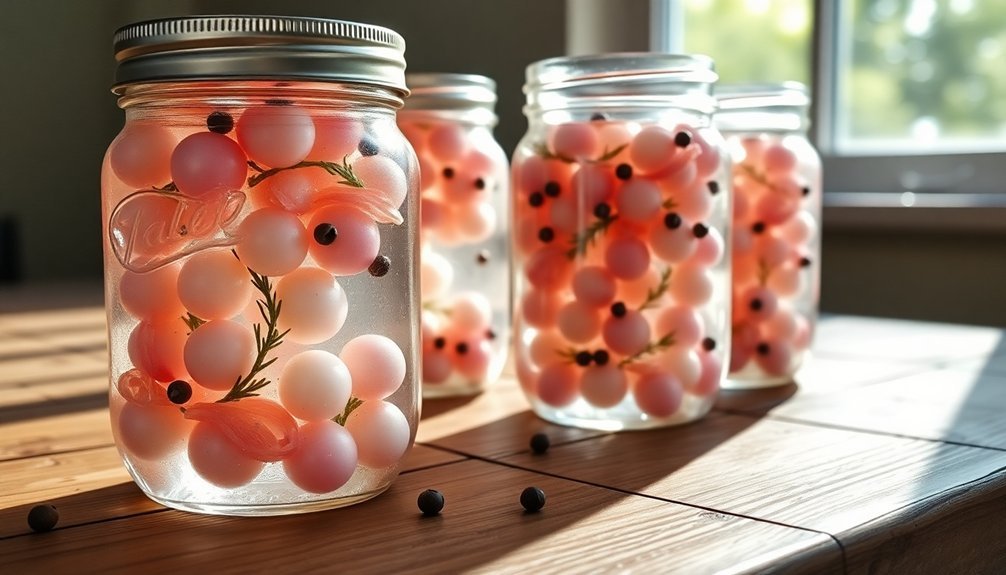



Leave a Reply